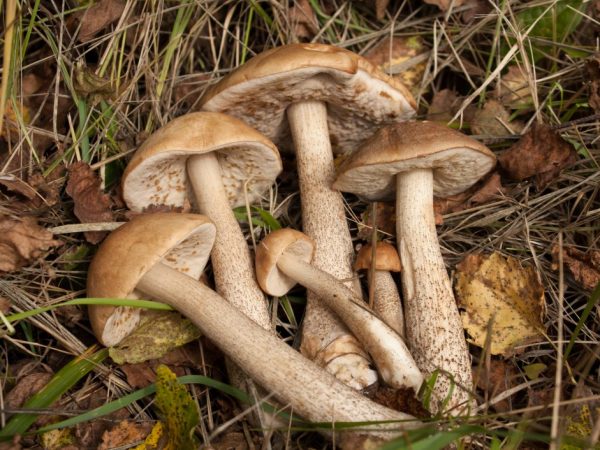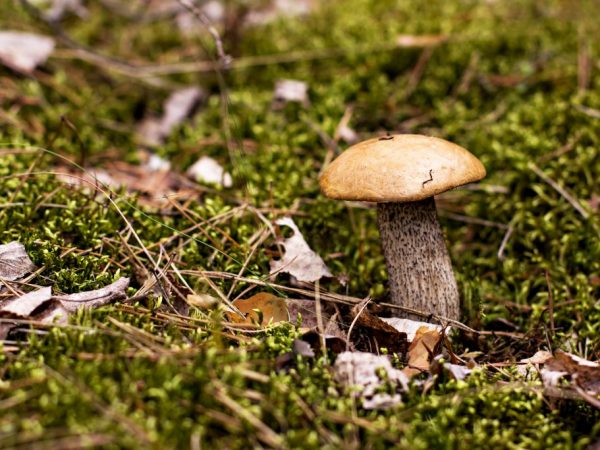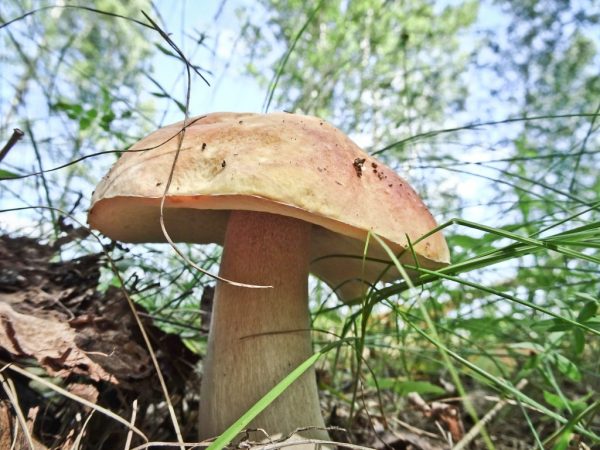Boletus mushroom
Boletus mushroom is one of the most delicious and healthy basidiomycetes. With its quality characteristics, it is equated to the kings of the forest - porcini mushrooms. Belongs to the Boletov family, the Obabok genus. In our forests, boletus mushroom is represented by several species. All of them are edible, but they differ in taste.

Boletus mushroom
general characteristics
The fungus forms mycorrhiza with birch, entering into symbiosis with it and actively spreading its hyphae. The relationship between the symbiont and fungal spores is interesting. The body is not a parasite and, growing next to a tree, helps it defend itself against foreign bacteria, improves the absorption of nutrients from the soil by the root system. On the territory of Russia, boletus was among the locals one of the main components of the diet in the autumn.
The mushroom cap is matte, has a hemispherical shape, painted in a grayish or pale chocolate color. As they grow older, it begins to resemble a pillow. Its diameter can reach 18 cm. When the humidity rises, sticky mucus appears on the surface of the cap.
The boletus looks like a boletus. The main differences are the shape of the leg, the color of the cap. Long, dense and fibrous stem, widening at the bottom, reaches 9-12 cm in height. The color of the leg is off-white. In the lower part, its surface is covered with small dark scales.
The hymenophore is tubular. It is painted white; as it grows, it becomes gray, watery-friable. The pulp is white and has a greenish tint. When cut, it turns slightly gray on contact with air. Delivers a pleasant mushroom aroma.
In young specimens, the fruit body is dense and delicate in taste, in old specimens it is loose, contains a large amount of moisture. Boletus grows singly or in groups. The harvesting season starts in May-June, depending on the region, and ends in late autumn. Spring boletus appears very first.
Views
There are more than 40 types of boletus boletus. The most popular among mushroom pickers:
- boletus ordinary;
- marsh boletus or white;
- boletus turning pink or oxidizing;
- gray boletus or hornbeam;
- black boletus, which is popularly called blackhead;
- boletus is multicolored.
On the territory of Russia, the most famous are common boletus and hornbeam. In addition to them, there are 7 more varieties. All types of boletus are edible mushrooms.
The false boletus, dangerous to human health, is distinguished by a pink color of the hymenophore in old representatives. A young false boletus has a white hymenophore. Young specimens are recognized by pressing on the spore-bearing layer: if it turns pink, then the mushroom is poisonous.
Birch obobok
Common boletus is a cap-and-leg edible mushroom that grows in birch plantings, deciduous, mixed forests. His hat is domed, with a diameter of 15 cm.Boletus has a cap color from dark chocolate to grayish, depending on the region in which it lives. The surface of the cap is thin or bare.
The hymenophore is tubular; it is effortlessly detached from the bottom of the cap. The young hymenophore is white; as it grows, it becomes grayish. Spores are olive brown. The fruit body is white, does not change color at all or acquires a slightly pink tint on the cut.
Bog
Marsh boletus or white birch, growing in small groups or singly in a humid area, is located on the outskirts of swamps and lakes. Appears in September after heavy rain. Fruiting until the end of autumn. Forms mycorrhiza with birch root system.

Only young mushrooms are suitable for food
The bog hat reaches 12 cm in diameter. The shape is convex, then pillow-like. The surface is dry, white or off-white. The old swamp is greenish-gray. Such specimens are no longer collected.
In young mushrooms, the hymenophore is tubular, gray-green. The pulp is watery, white, friable, does not change color on the cut. Exudes a mushroom aroma. The leg is high, thin, slightly widened at the bottom. It is painted white, covered with small scales.
Boletus turning pink (oxidizing)
Pink boletus (edible mushroom) forms mycorrhiza with woody and shrub birches. Collected P. pinking in northern forests, where he prefers to grow on the slopes of groves, in the highlands, on waterlogged soils. Appears in forests in autumn after heavy rains. Differs in a small cap, painted in yellow-brown color. The tubular white hymenophore later turns gray.
The white leg is shorter when compared to other mushrooms in this genus. Its surface is covered with a large number of gray scales. In some specimens, the legs are bent to the side from which more light falls. The pulp is white, dense, reddens at the cut.
Irina Selyutina (Biologist):
This type of boletus is characterized by a kind of "marble" color of the cap: brown areas are interspersed with lighter and even almost white in color. It is she who distinguishes p. Turning pink from ordinary in appearance. These mushrooms are also known in the northern part of Western Europe.
The mushroom belongs to the 2nd category of edibility.
Grabovik
The gray boletus is popularly called a hornbeam. A young specimen, growing in the same area where the p. Is oxidizing, is distinguished by a wrinkled structure of a hemispherical cap, its diameter is 6-15 cm. Its color palette is varied. The surface of the cap can be painted in the following colors:
- grey;
- yellow;
- the black;
- olive brown.
The leg, 6-18 cm high, is initially strongly swollen, later becomes cylindrical, narrowed downward. When pressed, it takes on a darker tone. Gray boletus mushrooms form mycorrhiza (mushroom root) with birches, oaks, beeches and nuts. Harvesting begins in the month of June, when rowan blossoms.
Blackhead
These mushrooms, growing on wet and swampy soils, are called "black" for the dark color of the cap. Wormy boletus of this species are very rare, which distinguishes them from other representatives of the genus.
The first mushrooms appear in the summer. The peak of fruiting is observed in September. If the summer was dry, they won't show up.
Description of the black boletus mushroom:
- hat 16 cm in diameter, matte black or chocolate brown;
- the surface of the fruiting body is dry, velvety to the touch, after rain and with increased humidity - sticky, slimy;
- the pulp has a hard structure, at the cut of the pores of the hymenophore they turn blue;
- the leg is off-white, thickened, about 12 cm high.
Colored obobok (multicolored)

Obboks are ideal for diet food
The main symbiont for the formation of mycorrhiza is birch, the secondary one is beech, aspen. Boletus Motley is painted in gray-white color, with pronounced strokes on the surface of the cap.In diameter, it reaches 12 cm.
The pulp is white, after a while it turns pink on the cut. The smell is barely perceptible. The tubular hymenophore is finely porous. Spores are light brown in color.
Irina Selyutina (Biologist):
If we compare common boletus and p. Multicolored, then the second has more compact dimensions, which is expressed in a smaller diameter of the cap, height and thickness of the leg. As the mushroom matures, the cap changes from closed to a slightly convex shape. The taste of the pulp is pleasant, although weak. The tubules of the hymenophore are finely porous, light gray in young specimens, light brown in adults, and dark spots may appear on them. When pressed, the tubes change color - turn pink. The length of the leg of the n. Multi-colored depends on the height of the moss in which they grow.
Fruiting from June to October, they are found mainly in swamps and mossy areas of the forest.
Beneficial features
Their high nutritional value and low calorie content make these mushrooms an indispensable ingredient in the diet of people looking to lose weight or gain muscle mass. The fibrous pulp, after heat treatment, tastes like meat. The chemical composition of boletus includes a protein that includes 8 essential amino acids that the human body is not able to synthesize on its own.
The pulp of the mushroom contains 35% protein, about 14% glucose, 4% fat, 25% fiber. Among the useful properties of the mushroom, the presence of a large amount of trace elements and vitamins is noted:
- thiamine;
- zinc;
- nicotinic acid (vitamin PP, vitamin B5, niacin);
- vitamins of group B, C, D, E, A;
- magnesium;
- sodium;
- phosphorus;
- iron;
- manganese.
This species holds the record for manganese content. Phosphoric (orthophosphoric) acid, present in the composition, has a positive effect on the work of the musculoskeletal system due to its participation in the construction of enzymatic cells. White mushroom (boletus) and boletus are considered competitive specimens. They have been actively used in folk and traditional medicine for a long time.
Contraindications
As such, there are no contraindications to the use of birch, but it is prohibited for individual intolerance. It is undesirable to prepare such food for children under 8 years old and people suffering from stomach ulcers. The fiber contained in mushrooms takes too long to digest, which can cause the stomach to "stop" in babies.
You should not collect boletus in forests located near factories, landfills, in public places and near highways. They accumulate toxins in themselves. An overripe mushroom is also dangerous.
Application

The mushroom can be used for medicinal purposes
Boletus is ranked among the delicious types of mushrooms, so most people only know about its use in cooking. In fact, this representative of Basidiomycetes can become a good substitute for drugs. The content of fiber and protein makes it possible to prepare dietary supplements for athletes on its basis.
Boletus will be useful in agriculture. After the burning of the mushroom bodies, ash is formed, which contains calcium, phosphorus, zinc and nitrogen, which provides stable nutrition and does not allow the soil to lose its quality. Mushroom products are suitable for formulating animal feed for cattle, pigs and poultry.
In cooking
The product must be processed before use. First, it should be cleaned of adhering dirt, remove the skin, cut off the lower part of the leg. If the product needs to be dried, it is not worth washing. Cleaning of dirt is carried out, and then the hat is simply wiped with a damp cloth.
So that the product prepared for gourmet dishes does not turn blue, after cleaning it is soaked in water with a small amount of lemon juice (juice from 0.5 fruit per 1 liter of water). It does not need to be soaked for several hours like milk mushrooms, 20-30 minutes is enough. Cooking technology involves double boiling. For the first time, boil the product only 5 minutes after boiling water.Then it is transferred to another pan, put a bay leaf, a whole onion, a couple of allspice peas, boil for 20-30 minutes until fully cooked.
Boiled raw materials are used for pickling, making soups, mushroom caviar, salads and other dishes. For the winter, you can prepare dried mushrooms or freeze fresh or boiled products in portions. Storage requires compliance with the rules:
- dried fruits with signs of mold must be disposed of;
- frozen products are used immediately and are not re-frozen;
- when the brine in the jar becomes cloudy, the product is disposed of.
In medicine
In folk medicine, it is used in tinctures and ointments to eliminate pain in osteochondrosis or gout. The affected areas should be treated 3-4 times a day. Tinctures are taken 2-3 times a day to enhance immunity and sexual activity. The individual components of Basidiomycete in combination with alcohol give an analgesic effect, eliminate nervousness (i.e., have some sedative effect).
The exceptional properties of this mushroom make it possible to use it in the manufacture of preparations for weight loss. In cosmetology, an extract from it is used as a rejuvenating component.
Growing
The domestication of basidiomycetes is being actively pursued. At home, it will be easy to grow a clearing with delicious mushrooms on your personal plot. You can plant spores collected on your own in the country or buy ready-made mycelium. Basidiomycete will bear fruit well in an area where there are birches from 2 to 4 years old.
If you need to collect spores with your own hands, pick up several old fruiting bodies. At a distance of 50 cm from the trunk, beds are made with a depth of 21-31 cm. Crushed stone is laid at the bottom, then coarse sand and a sod mixture. All this must be covered with a layer of high-quality compost.
If the hymenophore collected from mushrooms is solid, it is better to soak it together with gelatin and dolomite flour in a ratio of 1: 0.2: 0.3. The mixture is placed in the holes, covered with compost, on top they should be mulched with a sod mixture. Stably high soil moisture is maintained within 70%. To successfully grow a product on the site, special attention should be paid to harvesting. The main thing is to make sure that the mycelium producing shoots is not destroyed, otherwise this will be the last harvest.
An easier option is to buy a beginner's kit, which includes a special basket with "seed" material, substrate and detailed instructions. It is easy to find them in any specialty store.
Conclusion
Boletus is a delicious edible type of mushroom, which includes more than 40 subspecies. The name is due to the occurrence of symbiosis with birch. All representatives are rich in nutrients and minerals. Today, planting of forest basidiomycetes in summer cottages is actively practiced.



